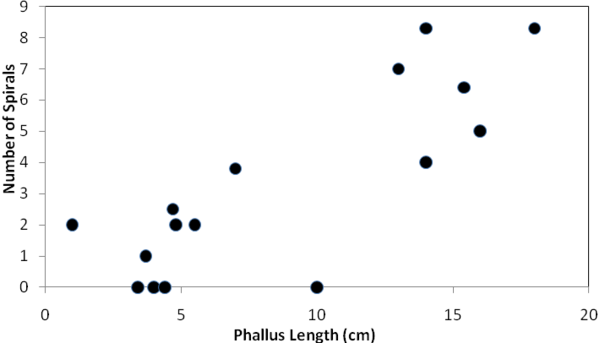| << Chapter < Page | Chapter >> Page > |
Brennan argues that it is due to sexual selection and conflict that these adaptations arose in the female mallard’s vagina (2007). Brennan produces some possibilities that it would not be including homology and natural selection (2007). She states that homology is impossible because the female oviducts begin from the Mullerian ducts whereas the male phallus comes from a ventral region of the cloaca and is homologous with the female hemi-phallus (2007). Natural selection to prevent water damage is also ruled out because of the extent to which the vagina specifically hinders the male phallus, and the similar phalluses that crocodiles have and use exclusively underwater (Brennan et al. 2007).

Birds that do not have phalluses use their cloaca, the opening used for urinating and defecating, to mate. The male occasionally has a stiffened pseudo-phallus developed during the breeding season which aids in his endeavors, and the two touch cloaca for a brief moment as sperm is transferred to the vagina in the so called “cloacal kiss” (Briskie 1997). In other birds, the female must evert her vagina into the male’s cloaca to receive the sperm, which gives her far greater control over whose sperm she selects.
As seen above, arranging the cloacal kiss can be extremely difficult in waterfowl. The intense awkwardness of this arrangement in waterfowl (the birds pictured above are American Coots) triggered some of the theories for the prevalence of intromittent organs among Anatidae species. These include: water damage prevention, maintaining genital contact, minimizing flight costs, and sperm competition (Briskie 1997). These theories may all play a role in the maintenance of IO’s, but currently, the strongest hypothesis is sexual selection. Photo from:<http://www.flickr.com/photos/kevcole/2499844531/>.
Recall that sexual conflict occurs when one sex obtains an advantage over the other. Mallards are socially monogamous, so females choose males during the breeding season and, quite surprisingly, attempt to remain faithful to them; however, males are polygamous despite their socially monogamous pairings, much like some humans (Adler 2010). In a purely monogamous society or one with fewer males than females, the male’s reproductive success would depend on the health of the female. However, if males used their intromittent organs and larger size, they could forcibly inseminate females either if they had no mate of their own or outside of their mate pair to increase their own reproductive success. This is exactly what is seen in the frequent extra-pair copulations and “rape flights” that mallards have. Recent experiments have also shown that the sizes and spirals of phalli in waterfowl directly correlate with the complexity of the corresponding vaginas and the occurrence of forced copulations within the species, see [link] & [link] (Brennan 2007)


Notification Switch
Would you like to follow the 'Mockingbird tales: readings in animal behavior' conversation and receive update notifications?